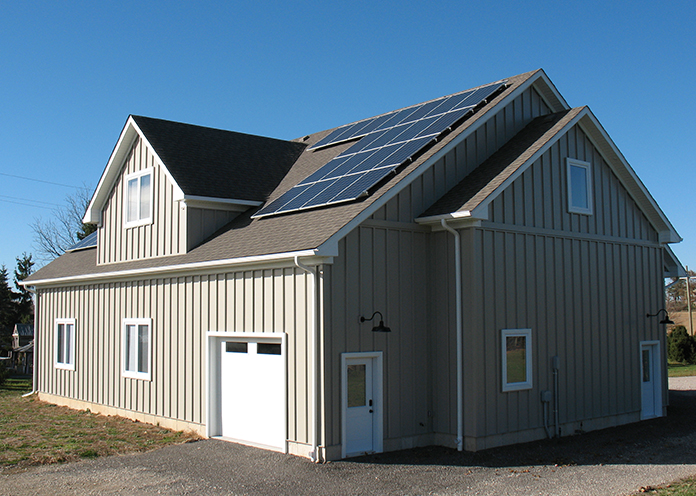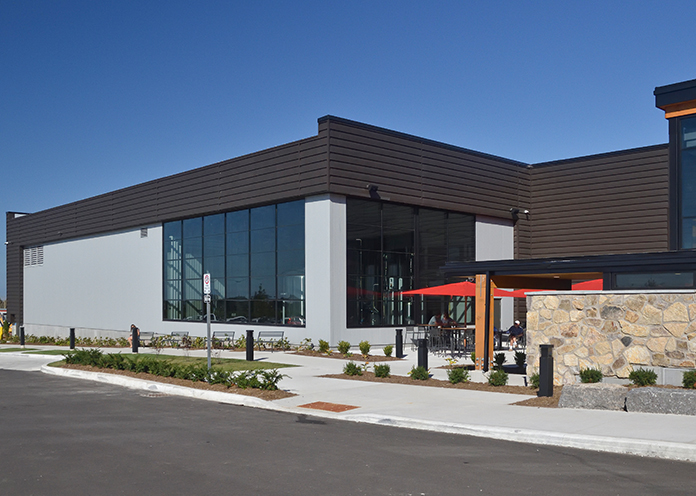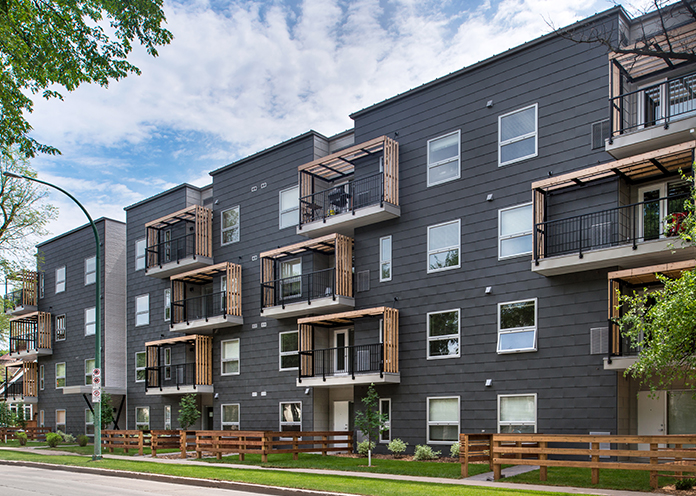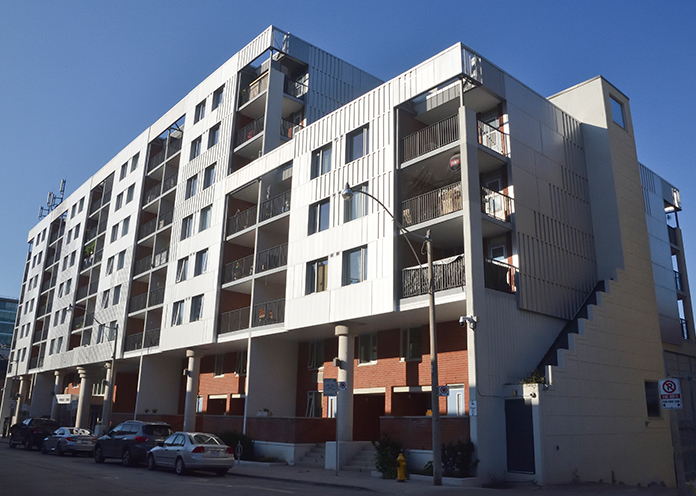LEEDV4
LEEDV4 and Steel
Designers and builders have long recognized steel for its strength, durability and functionality. An important aspect of steel’s story is its high recycled content and end-of-life recovery rate. Both attributes are recognized by the U.S. Green Building Council’s (USGBC) green building rating system, Leadership in Energy and Environmental Design (LEED), but steel construction products can contribute to many other LEED credits as well, either directly or indirectly.
USGBC’s latest version, LEEDv4, includes a completely revised and expanded Materials and Resources section, with new credits in the areas of life-cycle assessment (LCA), environmental product declarations (EPDs), and overall product transparency.
How Can Steel Contribute to a LEED V4 Project?
Steel is dimensionally stable and can be fabricated to exact specifications to minimize on-site waste. Its benefits include high strength, durability, material reduction through integrated design, recyclability, decreased maintenance cost and potential adaptive reuse. Steel construction products typically emit no volatile organic compounds (VOCs) on site, which contributes to better indoor air quality. The steel construction products industry has developed a wide range of EPDs which can assist project teams in evaluating environmental life cycle impacts.
This fact sheet explores the potential benefits steel construction products can provide to a project seeking LEED certification in accordance with the requirements of LEEDv4 for Building Design and Construction. (NOTE: The italicized text below represents selected excerpts from individual credits within LEEDv4, while commentary is shown in non-italicized, indented text. Please see the official LEEDv4 document for the complete text of these credits.)
Sustainable Sites (SS)
SS Credit: Site Development – Protect or Restore Habitat (1-2 Points)
Intent: Preserve and protect from all development and construction activity 40% of the greenfield area on the site (if such areas exist).
- Steel structures and steel components are often manufactured with much of the construction process occurring away from the project site. Reducing the amount of time spent onsite and reducing the need for onsite fabrication may decrease the likelihood of site disturbance.
SS Credit: Heat Island Reduction (1-2 Points)
Intent: To minimize effects on microclimates and human and wildlife habitats by reducing heat islands.
Option 1: Non-roof and Roof (2 points except Healthcare, 1 point Healthcare)
Meet the following criterion:

Alternatively, an SRI and SR weighted average approach may be used to calculate compliance.
High-Reflectance Roof
Use roofing materials that have an SRI equal to or greater than the values in Table 1. Meet the three-year aged SRI value. If three-year aged value information is not available, use materials that meet the initial SRI value.

Option 2: Parking under Cover (1 point)
Place a minimum of 75% of parking spaces under cover. Any roof used to shade or cover parking must (1) have a three-year aged SRI of at least 32 (if three-year aged value information is not available, use materials with an initial SRI of at least 39 at installation).
- Many steel roofing products are available that meet the solar reflectance and/or SRI criteria in this credit, resulting in reduced cooling loads and lower utility bills. Some of these products utilize reflective pigment technology, which allows for a wider range of colors that meet the LEEDv4 requirements. See Cool Metal Roofing for information on cool metal roofing products. Click here for a complete list of initial and 3-year-aged solar reflectance values for specific steel roof products.
Energy and Atmosphere (EA)
EA Prerequisite: Minimum Energy Performance (Required)
EA Credit: Optimize Energy Performance (1-20 Points)
Intent: To achieve increasing levels of energy performance beyond the prerequisite standard to reduce environmental and economic harms associated with excessive energy use.
- Because of its dimensional stability, properly designed steel framing can contribute to an exceptionally tight building envelope, resulting in reduced air loss and better building energy performance over time.
EA Credit: Renewable Energy Production (1-3 Points)
- Steel roofs provide an excellent platform for solar photovoltaic (PV) systems because their expected lifespan equals or exceeds the 20- to 30-year expected life of typical solar PV panels. Additionally, proprietary connection and framing systems are available for mounting PV panels directly to the standing seams of steel roofing panels, eliminating the need for roof penetration attachments.
Materials and Resources (MR)
MR Prerequisite: Construction and Demolition Waste Management Planning
Intent: To reduce construction and demolition waste disposed of in landfills and incineration facilities by recovering, reusing, and recycling materials.
- Steel construction products can be manufactured and/or fabricated to precise specifications, resulting in minimal job site scrap, all of which can be easily recycled through the existing infrastructure of readily-available scrap processing facilities.
MR Credit: Building Life Cycle Impact Reduction (2-6 Points)
Intent: To encourage adaptive reuse and optimize the environmental performance of products and materials.
Option 1: Historic Building Reuse
Option 2: Renovation of Abandoned or Blighted Building
Option 3: Building and Material Reuse
- The long-life durable nature of steel buildings makes them particularly suitable for renovation and reuse. Bolted or screwed connections present little challenge to disassembly, and welded connections can be cut without distorting or severely limiting reuse of the remaining members. Steel framing systems can provide long spans and large column-free spaces that are adaptable and flexible, and steel partitions can be easily relocated to new positions within the building.
Option 4: Whole Building Life Cycle Assessment (3 points)
For new construction (buildings or portions of buildings), conduct a life-cycle assessment of the project’s structure and enclosure that demonstrates a minimum of 10% reduction, compared with a baseline building, in at least three of the six impact categories listed below, one of which must be global warming potential. No impact category assessed as part of the life-cycle assessment may increase by more than 5% compared with the baseline building.
- In addition to environmental product declarations (EPDs), life cycle inventory (LCI) data is available for nearly all steel construction products, allowing designers to easily complete the whole building life cycle assessment (LCA) process as required by this credit. LCI data for semi-finished steel products (including hot-rolled structural sections and cold-formed steel framing) is available at the Steel Recycling Institute.
MR Credit: Building Product Disclosures and Optimization – Environmental Product Declarations (1-2 Points)
Option 1: Environmental Product Declaration (EPD) (1 point)
Use at least 20 different permanently installed products sourced from at least five different manufacturers that meet one of the disclosure criteria below.
- Product-specific declaration
- Products with a publicly available, critically reviewed life-cycle assessment conforming to ISO 14044 that have at least a cradle to gate scope are valued as one quarter (1/4) of a product for the purposes of credit achievement calculation.
- Environmental Product Declarations which conform to ISO 14025, 14040, 14044, and EN 15804 or ISO 21930 and have at least a cradle to gate scope.
- Industry-wide (generic) EPD — Products with third-party certification (Type III), including external verification, in which the manufacturer is explicitly recognized as a participant by the program operator are valued as one half (1/2) of a product for purposes of credit achievement calculation.
- Product-specific Type III EPD — Products with third-party certification (Type III), including external verification in which the manufacturer is explicitly recognized as the participant by the program operator are valued as one whole product for purposes of credit achievement calculation.
- USGBC approved program – Products that comply with other USGBC approved environmental product declaration frameworks.
Option 2: Multi-Attribute Optimization (1 point)
Use products that comply with one of the criteria below for 50%, by cost, of the total value of permanently installed products in the project. Products will be valued as below.
- Third party certified products that demonstrate impact reduction below industry average in at least three of the following categories are valued at 100% of their cost for credit achievement calculations.
- global warming potential (greenhouse gases), in CO2e;
- depletion of the stratospheric ozone layer, in kg CFC-11;
- acidification of land and water sources, in moles H+ or kg SO2;
- eutrophication, in kg nitrogen or kg phosphate;
- formation of tropospheric ozone, in kg NOx, kg O3 eq, or kg ethene; and
- depletion of nonrenewable energy resources, in MJ.
- USGBC approved program — Products that comply with other USGBC approved multi-attribute frameworks.
For credit achievement calculation, products sourced (extracted, manufactured, purchased) within 100 miles (160 km) of the project site are valued at 200% of their base contributing cost.
Structure and enclosure materials may not constitute more than 30% of the value of compliant building products.
- Environmental Product Declarations (EPDs) can be valuable tools for designing environmentally responsible buildings. An EPD is a summary of the results of a life cycle assessment (LCA), which describes the environmental impacts of products in a number of specific categories. Industry-wide EPDs are available for most major categories of North American steel construction products, including cold-formed steel framing (studs and track), structural steel and steel plate, primary and secondary steel frames, steel floor and roof deck, steel joists, and steel roofing and wall cladding products. A list of industry-wide steel product EPDs can be found here. In addition to these industry-wide EPDs, many manufacturers have published product-specific EPDs that may meet the requirements of Option 2.
MR Credit: Building Product Disclosure and Optimization – Sourcing of Raw Materials (1-2 Points)
Intent: To encourage the use of products and materials for which life cycle information is available and that have environmentally, economically, and socially preferable life cycle impacts. To reward project teams for selecting products verified to have been extracted or sourced in a responsible manner.
Option 1: Raw Material Source and Extraction Reporting (1 point)
- Products contributing to this credit must have a self-declared report (valued at ½ of a product) or a third-party verified report (valued as a full product) that describes the environmental impacts of extraction operations and activities associated with the manufacturer’s product and the product’s supply chain, using one of the corporate sustainability report (CSR) frameworks listed in the credit, such as the Global Reporting Initiative (GRI). Several North American steel producers publish such CSR reports annually. Contact specific steel producers for a copy of their CSR report.
Option 2: Leadership Extraction Practices (1 point)
Use products that meet at least one of the responsible extraction criteria below for at least 25%, by cost, of the total value of permanently installed building products in the project.
- Extended producer responsibility
- Bio-based materials
- Wood products
- Materials reuse
- Recycled content – Recycled content is the sum of post-consumer recycled content plus one-half the pre-consumer recycled content, based on cost. Products meeting recycled content criteria are valued at 100% of their cost for the purposes of credit achievement calculation.
- USGBC approved program – Other USGBC approved programs meeting leadership extraction criteria.
Structure and enclosure materials may not constitute more than 30% of the value of compliant building products.
- All steel structures and steel construction products contain significant levels of recycled content. Additionally, many steel products recovered from demolition or refurbishment projects are suitable for reuse. The LEEDv4 Reference Guide (page 535) allows a default value of 25 percent post-consumer recycled content for any steel product. However, some steel products (e.g. structural sections and reinforcing bar) may have recycled content levels as high as 100%. These higher values may be used in the LEED credit calculations if company-specific recycled content information is available from the steel product supplier. As described in the LEEDv4 Reference Guide (page 536), industry-wide or national average recycled content values may not be used in calculations to support achievement of this credit.
MR Credit: Building Product Disclosure and Optimization – Material Ingredients (1-2 Points)
Option 1: Material Ingredient Reporting (1 point)
Use at least 20 different permanently installed products from at least five different manufacturers that use any of the following programs to demonstrate the chemical inventory of the product to at least 0.1% (1000 ppm).
- Manufacturer Inventory
- Health Product Declaration
- Cradle to Cradle
- Declare
- ANSI/BIFMA e3 Furniture Sustainability Standard
- Cradle to Cradle Material Health Certificate
- USGBC approved program
And/Or
Option 2: Material Ingredient Optimization (1 point)
Use products that document their material ingredient optimization using the paths below for at least 25%, by cost, of the total value of permanently installed products in the project.
- GreenScreen v1.2 Benchmark
- Cradle to Cradle Certified
- International Alternative Compliance Path – REACH Optimization
- USGBC approved program
And/Or
Option 3: Product Manufacturer Supply Chain Optimization (1 point)
- This credit encourages the disclosure of comprehensive ingredient information (Option 1 – 1 point) and optimization of these ingredients (Option 2 – 1 additional point) for a specified number of products. The credit generally applies to end-use products as delivered to the jobsite. Option 1 can be achieved by developing a “… publicly available inventory of all ingredients identified by name and Chemical Abstract Service Registration Number (CASRN)”. Additional compliance options for Option 1 include a Health Product Declaration (HPD), Cradle to Cradle certification, and the Declare label. Compliance with Option 2 requires material ingredient optimization using the GreenScreen v1.2 Benchmark, Cradle to Cradle certification (at higher levels than Option 1), REACH Optimization, or other USGBC approved program. Some steel construction products have met the requirements of Option 1 and/or Option 2, and many others are in the process of meeting these requirements. Contact the specific steel product manufacturer for currently available information.
MR Credit: Design for Flexibility (1 Point, Applies to Healthcare Only)
Intent: Conserve resources associated with the construction and management of buildings by designing for flexibility and ease of future adaptation and for the service life of components and assemblies.
- Cold-formed steel partitions can easily be removed, reused, and/or relocated as part of a building modification. Structural steel framing can be easily modified for changes in loading requirements and/or changes to intended use or occupancy.
MR Credit: Construction and Demolition Waste Management (1-2 Points)
Option 1. Diversion (1–2 points)
Path 1. Divert 50% and Three Material Streams (1 point)
Divert at least 50% of the total construction and demolition material; diverted materials must include at least three material streams.
Or
Path 2. Divert 75% and Four Material Streams (2 points)
Divert at least 75% of the total construction and demolition material; diverted materials must include at least four material streams.
Or
Option 2. Reduction of Total Waste Material (2 points)
Do not generate more than 2.5 pounds of construction waste per square foot (12.2 kilograms of waste per square meter) of the building’s floor area.
- Steel products can nearly always make a significant contribution to this credit. Relative to Option 2, most steel construction products are manufactured or pre-cut to finished size, or fabricated to precise project specifications, prior to shipment to the jobsite. This results in minimal jobsite steel waste, such that steel contributes very little to the 2.5 pounds per square foot limit.
- Alternatively, if Option 1 is chosen as the target for compliance with this credit, 100% of the steel scrap generated at the jobsite can be easily and economically recycled, so that steel can be a positive contributor to either Path 1 or Path 2.





